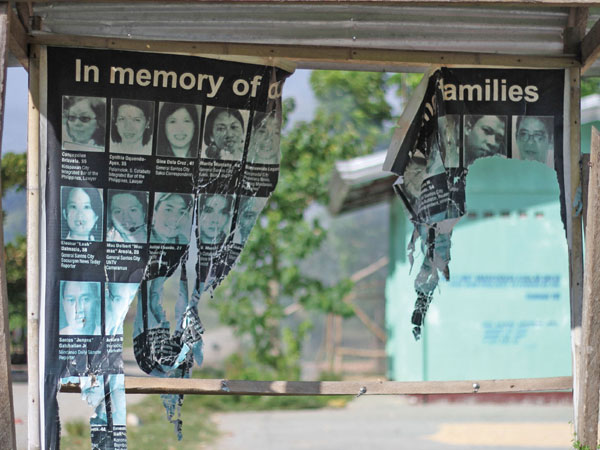
SLOW WHEEL OF JUSTICE It has been three years since the Maguindanao massacre, but the 58 victims whose pictures appear on the tattered tarpaulin at the site of the Philippines’ worst political crime have yet to be served justice. KARLOS MANLUPIG/INQUIRER MINDANAO
COTABATO CITY—Three years after the Maguindanao massacre, fear still stalks surviving relatives of the 58 people slaughtered in the worst political violence in the nation’s history.
Even Maguindanao Gov. Esmael Mangudadatu, whose wife, two sisters and supporters were among those killed, would not say categorically if he would attend the ecumenical rites at Salman village in Ampatuan town, the site of the bloodbath on Nov. 23, 2009.
Justice Secretary Leila de Lima and the late Interior Secretary Jesse Robredo attended the two previous anniversary rites.
Asked if any national official is coming to the ceremony on Friday, the governor said no. He said that his brother, Buluan Mayor Ebrahim Mangudadatu, would lead the memorial rites.
“There will be an ecumenical prayer,” Mangudadatu said.
He declined to inform the media of his whereabouts on Friday, except to say that a “short program” had been prepared for the anniversary.
Apprehension remains despite police and military assurances that the area has been amply secured, according to a Mangudadatu aide.
“For security reasons, we cannot say something definite, especially with the advent of modern communication gadgets,” he said.
The governor said soldiers under the military’s 6th Division had been mobilized to clear the vicinity of Salman village.
Provincial board members Yasser and Sarip Ampatuan, two close relatives of the alleged massacre mastermind, former Maguindanao Gov. Andal Ampatuan Sr., are expected in Friday’s event. Mangudadatu has described Yasser and Sarip as “good Ampatuans.”
Threats vs media
The victims, including 32 journalists, were in a convoy on the way to file Mangudadatu’s certificate of candidacy for governor when they were intercepted by men armed with automatic rifles and machetes. Some of the women were raped before they were killed. The bodies were later dumped into mass graves dug up by a backhoe.
Ampatuan Sr., his son, former Datu Unsay Mayor Andal Ampatuan Jr., his other son, Zaldy Ampatuan, the former governor of the Autonomous Region in Muslim Mindanao, are jailed while being tried in Manila for the massacre. At least 92 of the almost 200 suspects are still at large.
The families of the slain journalists announced they would not attend the anniversary rites.
“The families of slain [journalists] were concerned about their safety. So we decided not to visit the site and instead agreed to stage a protest march from the city proper to Forest Lake (Memorial Park) on Nov. 23,” said Grace Morales, wife of slain journalist Rosell Morales and Justice Now Movement secretary general.
In August, Morales reported that unidentified men came to her house in General Santos City and asked where she was.
Early this month, Catherine Nuñez, mother of slain UNTV cameraman Victor Nuñez, reported that suspicious-looking men went to her neighborhood in General Santos City on the evening of Oct. 12 and asked where she was. It was the fourth incident involving Nuñez, the most vocal of the victims’ relatives.
‘Impuni-trees’
At the University of the Philippines-Diliman, students of the College of Mass Communication on Wednesday planted “impuni-trees” to serve as reminders of the journalists killed in Maguindanao, described as the single most atrocious assault on press freedom in the country.
Dean Roland Tolentino said that the two trees of impunity planted in the front and rear portions of the Plaridel Hall on the campus would remind students and future journalists of the continuing call for justice in the 2009 carnage.
“They have to see something concrete, an entity that is alive, so they would feel that the search for justice is real and is still happening,” Tolentino told the Philippine Daily Inquirer.
“There is no longer consciousness among them about the massacre when it is important to them being future media practitioners,” he said.
A sign beside one tree read: “May this impuni-tree serve as a reminder to collectively and objectively analyze the social situation, systemic issues—especially impunity… are rooted in age-old problems in the country. To achieve our common objective to end impunity, let us unite to strike at the root of the problem.” With a report from Jeannette I. Andrade